Neal Rolls the Dice on Rococo Revival--and Wins
February 1st, 2015
|
Big and boisterous, this nine-piece bedroom suite (partially shown) from the Service collection is in the Renaissance style referred to as “Henry II.” Altogether it’s a great deal of carved oak furniture for $52,580 (est. $15,000/25,000).
Grant Oakes purchased both chandeliers and table lamps for the Service collection. Most ornate—with figures of Nike holding the shades aloft—was this pair of late Regency sinumbra lamps, circa 1830, Messenger & Sons, Birmingham, England, which brought $25,095 (est. $7000/10,000).
While paintings were not the focus of this auction, The Bayou at Lafitte by New Orleans artist Clarence Millet (1897-1959) was a perfect expression of Louisiana life on the water. The work, which brought $53,580 (est. $10,000/15,000), had been purchased from the artist when he presented it at the National Art Week Exhibition in New Orleans in 1941.
This Rococo Revival two-light Argand chandelier in gilt bronze, probably English, was ornamented with masks and grapes and sold for $13,530 (est. $3000/5000). A pair of three-light Argand chandeliers (not shown) brought $20,315 (est. $6000/8000). Service collection.
An eight-piece parlor suite (partially shown) of Rococo Revival parlor seating in the showy “Bird” pattern sold to a phone bidder for $83,650. The set included two sofas, two armchairs, and four side chairs.
Top lot of the sale was a Belter-attributed laminated rosewood circular center table that sold for $86,637.50 (est. $25,000/40,000). It is similar to examples at the Metropolitan Museum of Art and in the Lincoln Bedroom at the White House. |
Neal Auction Company, New Orleans, Louisiana
Photos courtesy Neal Auction Company
At the midpoint of Neal’s Louisiana Purchase auction last November, company president Neal Alford was already talking about the important estate he had on the schedule for early 2015.
Alford was talking about what he referred to as the Service collection of Grant A. Oakes (1938-2010), a businessman in Warren, Ohio, who started a company called Service Guide Inc. Oakes liked 1932 Fords as well, but he will always be best known for his collection of 19th-century Rococo Revival and Renaissance Revival furniture and lighting. A selection of lots from his estate in the January 31 and February 1 sale accounted for over $800,000 of the $2.4 million total.
Alford said, “Throughout the 1980s, he was the strongest collector of American Rococo nineteenth-century furniture, primarily focused on known Belter works.” Oakes obviously admired accomplished carving, and he bought the best of the best of his chosen period. Some find the style a bit much, but Rococo Revival is seductive, and the artistry captures the imagination. Alford is president and auctioneer, but he is also Neal’s enthusiastic 19th-century furniture guy. Notable in the Service collection were two small round tables, both estimated at $20,000/30,000, which sold on Sunday morning for $54,970 (includes buyer’s premium) and $60,945.
“There are two small circular tables that are drop-dead gorgeous,” Alford said. “You can see in those that John Henry Belter…was having an innovative moment. He had a genius for doing what he does. The delicacy of the lamination in those small tables is phenomenal. Whoever Belter was, he had a great understanding of the eighteenth century—of the forms, of his sources. He was somewhat of a purist in his understanding of Rococo design. The guy was a genius and an aesthete, and the laminating process got him to where he wanted to go.”
Discussing the collection as a whole before the sale, he continued, “This material was very carefully chosen by someone with the wherewithal to make choices and be able to afford them. Oakes wanted the best, was able to pay for the best, and ended up with the best. There’s no collection anywhere that has the quantitative consistency that this does. It’s representative of the very best work by a maker who has a very short tenure—so it’s even more intense than the way we’re talking about it. I think the marketplace for this particular group, which is…very sophisticated, I think the market for this material will be competitive with collectors of nineteenth-century American furniture and decorative arts. I think they’re going to be enamored of the qualitative superiority of this group.” Alford’s opinion was justified by the results. The estimates proved accurate and were consistently met or surpassed, sometimes in spectacular fashion.
Collectors had long known about the Service collection because so many individual pieces had been published. Many of them had appeared in the Dubrows’ American Furniture of the 19th Century, 1840-1880. Lighting of the period had been another passion of Oakes, and a number of those lots had been illustrated in 19th Century Elegant Lighting: Argand, Sinumbra, and Solar Lamps by Gerald T. Gowitt.
As noted, Oakes had been avidly collecting back in the 1980s, a decade when another great Rococo Revival collection, that of Gloria and Richard Manney, who had begun collecting in the 1960s, went on view at Winterthur. While agreeing that prices may have been very strong in the ’80s and ’90s, Alford pointed out that collections returning to the market are part of the regular auction cycle: “You’re going to see more and more of that, I suppose. Collections that were built thirty or forty years ago are coming to auction. A lot of the material will be deaccessioned from those collections, throughout the marketplace. Certainly, you hit the nail on the head in regard to a certain aspect of this group here coming to sale. They were collected, generally speaking, thirty years ago—and that’s what sales looked like then. What you’re seeing now is a pretty tight collection in this particular sale. It’s something we’re going to experience over and over. And this type of quality typically will attract newcomers to this area of collecting.”
While the Service collection made up most of the top-20 lots, the two-day sale presented several other strong collections, including historic maps, prints, and books from the estate of Donald E. Pierce, who was a physician in Greenwood, Mississippi, before retiring to Santa Fe. Marc Fagan at Neal handles these specialties and made several trips to New Mexico to examine the collection. Fagan found that Dr. Pierce had been an omnivorous collector with many interests: “Maps were just one part of his collection, but that part was very, very deep. He had a reference library of thousands of books, and hundreds were on maps. He came from Mississippi, and there are a lot of maps from that area, not just pretty maps but informative maps, esoteric maps about elevations and surveys of the Mississippi River. And then he moved out to Santa Fe and started buying Western things. All in all, it’s a pretty cool collection.”
 One lot that Fagan expected to do well was “Lloyd’s Map of the Lower Mississippi River,” which ended up selling for $11,352.50 (est. $5000/7000). He explained, “It was a really good-looking wall map of Mississippi that’s pretty scarce, a map on rollers….That particular map was contested by a Texan who owns property indicated on the map and a Californian who owns a commercial interest in a town indicated on the map—the Texan won.” The Pierce material is being sold to benefit the Museum of New Mexico Foundation and brought a total of $124,000; more of the collection will be sold later.
One lot that Fagan expected to do well was “Lloyd’s Map of the Lower Mississippi River,” which ended up selling for $11,352.50 (est. $5000/7000). He explained, “It was a really good-looking wall map of Mississippi that’s pretty scarce, a map on rollers….That particular map was contested by a Texan who owns property indicated on the map and a Californian who owns a commercial interest in a town indicated on the map—the Texan won.” The Pierce material is being sold to benefit the Museum of New Mexico Foundation and brought a total of $124,000; more of the collection will be sold later.
For more information, call (800) 467-5329 or visit the website (www.nealauction.com).
|
|
|
|
|
|
|
|
|
|
Originally published in the May 2015 issue of Maine Antique Digest. © 2015 Maine Antique Digest

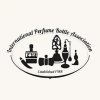


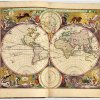






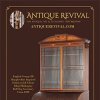













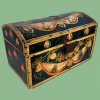












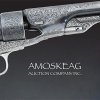

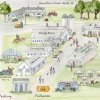
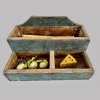






 An outstanding lot from the Donald E. Pierce collection of maps, “Lloyd’s Map of the Lower Mississippi River…,” 1863, New York, sold for $11,352.50 (est. $5000/7000) to a Texas collector. The proceeds benefit the Museum of New Mexico Foundation.
An outstanding lot from the Donald E. Pierce collection of maps, “Lloyd’s Map of the Lower Mississippi River…,” 1863, New York, sold for $11,352.50 (est. $5000/7000) to a Texas collector. The proceeds benefit the Museum of New Mexico Foundation. The étagère form in Rococo Revival parlors became an art form in itself, reflecting the splendor of the room. This elaborate rosewood example with putti and fruit carving sold for $44,812.50.
The étagère form in Rococo Revival parlors became an art form in itself, reflecting the splendor of the room. This elaborate rosewood example with putti and fruit carving sold for $44,812.50. This near pair of Belter-attributed circular tables—one with a basket of fruit, the other with flowers—sold for $54,970 and $60,945 respectively. They are smaller than a traditional center table (both are around 25" in diameter). The catalog cited a very similar table purchased from Belter in 1853 for a Nashville mansion. They are from the Service collection.
This near pair of Belter-attributed circular tables—one with a basket of fruit, the other with flowers—sold for $54,970 and $60,945 respectively. They are smaller than a traditional center table (both are around 25" in diameter). The catalog cited a very similar table purchased from Belter in 1853 for a Nashville mansion. They are from the Service collection. Later 19th-century hall seats are never estimate-breaking stars, but the two offered on Sunday at the Carondelet Gallery were masterpieces of their decorative form. This carved oak example with lions on the crest and winged creatures for arm supports, attributed to R.J. Horner, New York, 1880-1900, brought $21,510 (est. $2500/3500). Two lots beyond, an even more ornate Renaissance-inspired bench from the same maker (not shown) sold for $19,120 (est. $2500/3500). The Service collection provenance certainly added to their value.
Later 19th-century hall seats are never estimate-breaking stars, but the two offered on Sunday at the Carondelet Gallery were masterpieces of their decorative form. This carved oak example with lions on the crest and winged creatures for arm supports, attributed to R.J. Horner, New York, 1880-1900, brought $21,510 (est. $2500/3500). Two lots beyond, an even more ornate Renaissance-inspired bench from the same maker (not shown) sold for $19,120 (est. $2500/3500). The Service collection provenance certainly added to their value. Only a muscular porter with a cart could have moved this large Louis Vuitton wardrobe trunk that was from the 1930s-40s era of ocean travel. The trunk, from Marshall Field’s in Chicago, still had its interior fittings and brought $9150 (est. $3000/5000).
Only a muscular porter with a cart could have moved this large Louis Vuitton wardrobe trunk that was from the 1930s-40s era of ocean travel. The trunk, from Marshall Field’s in Chicago, still had its interior fittings and brought $9150 (est. $3000/5000).


